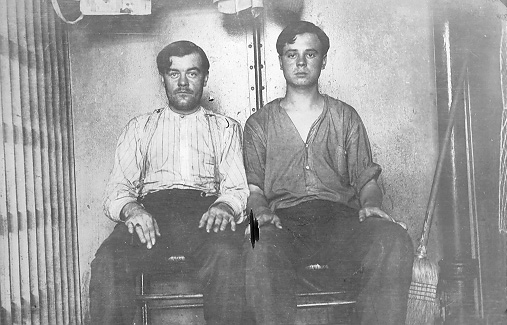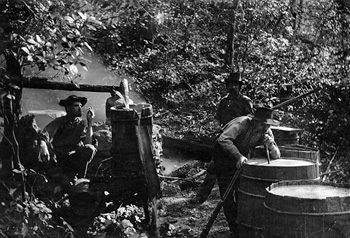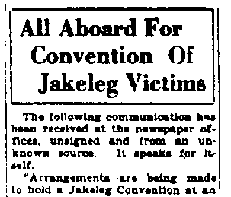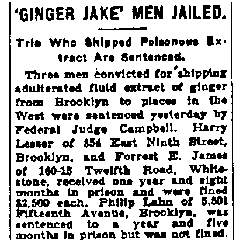
Actually, when you get right down to it, the actual way to drink moonshine isn't really that different from the way you drink anything else. Well, maybe you take smaller sips.
Folk songs about the pleasures of drinking moonshine, and the pain that often follows, were popular in the 1930s and 1940s.


Jake Leg Blues by Willie Loften
Miss Moonshine by Frankie Marvin
Moonshine Kate, Part II by Fiddlin' John Carson

A whiskey tax in the United States first became on economic issue in 1794, when the so-called "Whiskey Rebellion" broke out along the western frontier, which then stood in western Pennsylvania and eastern Ohio.
With the onset of the Civil War, the Federal Government re-imposed excise taxes on whiskey and tobacco in an effort to fund Union army. After the war ended, the Reconstructionist government decided to keep the taxes in place, it turned out that re-building the nation was just as expensive as fighting to keep it together. Faced with enormous debts, both state and federal governments continued to collect and enforce the whiskey taxes.
The Revenue Bureau of the Treasury Department was formed after the Civil War, and was headed by Commisioner Green B. Raum from 1876-1883. During this time Raum transformed the revenue collectors into a police agency, actively seeking out moonshiners in their home enviornments. They acted as a national authority, regardless of state lines.
North Carolina Senator Zebulon Vance campaigned against revenue laws in 1876, terming the revenue agents as "red-legged grasshoppers." Because of the revenuers, Vance complained, "The time has come when an honest man can't take an honest drink without having a gang of revenue officers after him."

Congress increased the whiskey tax to $1.10 per gallon in 1894, a stiff tax. While the increase was intended to up the government's take in "revenue", it ended up creating a boom in untaxed liquor. More and more distillers decided the only way they could continue under the new tax was to sell their product illegally. By it's own estimate, the government guessed that between 5 and 10 million gallons of illegal liquor were produced and sold annually in and around 1896.
Moonshining was popular in many places in the South during the last part of the 19th century and the first part of the 20th century, but was concentrated in the Blue Ridge mountains, eastern Tennessee, western North Carolina, northern Georgia, and western South Carolina. The rise of local and state-wide temperance or prohibition movements increased the demand for their supply.
Images courtesy of the John C. and Olive Campell Collection, Southern Historical Collection, University of North Carolina
One reporter in the 1920's described drinking moonshine this way:
"The instant he swallowed the stuff he feels as if he were sunburned all over, his head begins to buzz as if a hive of bees had swarmed there, when he closed his eyes, he sees six hundred million torch-light processions all charging at him, ten abreast, and when he opens his eyes the light blinds him and everything seems dancing about."
It's probably obvious that there are no health standards, no regulatory bodies, that govern the production of moonshine. For generations, moonshine has been made in home- made stills, hidden from sight. The forest, or a swamp, is often the easiest place to locate a still; those located closer to home can be found in barns, chicken coops, or buried underground.
While quality control and sanitation are probably not of the utmost importance to many people who drink moonshine (after all, alcohol kills many bateria, right?), people are sometimes concerned about whether or not the moonshine they just bought is safe to drink. After all, people go blind from drinking bad moonshine, and it has also been known to cause neurological damage, including paralysis.
Moonshiners often add some "extra" ingredients, either intentionally or accidently, in the process of distilling their liquor. Some of these include:
- lye
- rubbing alcohol
- wood alcohol
- paint thinner
- bleach
- formaldehyde
- embalming fluid
- chemical fertilizers
- manure
Depending on the type of still used, pine pitch or lead often leeches into the liquor. The lead is particularly dangerous because it is virtually undectable, and if consumed lead has a cumulative effect on the human body.
While the mash is fermenting in a still in the woods, it is not uncommon for insects and small animals to come and drink from the still. They can fall in and sink to the bottom of the mash.
Serious medical symptoms, different from the ones associated with legally manufactured alcohol, often result from drinking moonshine. Often these symptoms are immediate, sometimes they're temporary, but sometimes they're permanent. People go blind from drinking moonshine, or suffer nerve damage or develop sores or ulcers.

Clipping from the Johnson City Staff News.
In the 1930s, though, a specific affliction struck moonshine drinkers in a number of Southern states. It is estimated that some 50,000 people were crippled with partial paralysis, mostly in their legs, as a result of drinking "jake". In some cases the paralysis proved to be temporary, but nearly all victims were forced to walk with in high-stepping, foot-slapping style that quickly became known as the "jake walk" or the "jake leg".
Jake is actually Jamacian ginger extract, marketed and sold as a medicinal tonic for any number of ills. It was available in the United States since about the time of the Civil War, and Americans quickly realized that the nearly 70% alcohol content made "the jake" a way to skirt local or federal laws banning the consumption of liquor. Compared to whiskey, jake was often cheaper, and often had a higher alcohol content. Many drug stores sold Coca-Cola or coffee, which people would then use as mixers for the jake, often using a side room in the store to concoct their drink.

Clipping from the New York Times, June 1, 1935.
Jake sold between 1920 and 1930 caused no health problems. In the spring of 1930, however, the manufacturers of jake decided to add a new ingredient, an industrial chemical called tri-ortho-cresyl phosphate.
The new ingredient was added to help adulter, or water down, the jake. It was tasteless, soluble with alcohol, and cheap. It also turned out to be highly toxic, particularly to the spinal cord.
Technically, jake is not really moonshine. It was manufactured and distributed legally, intended for medical use. But the way jake was used, to subvert Prohibition, to provide a relatively cheap means of getting drunk while avoiding paying federal liquor tax, creates a close connection to jake and the more traditional bootleg liquor. And, like moonshine, jake proved to have the potential for severe health problems. So while the victims of moonshine were often unrecorded or attributed to something else, many victims of jake paralysis have been documented, both in medical records and in song.
Nearly all of the early victims of "the jake walk" were white men, many middle-aged. It has been theorized that the apparent lack of black victims may be evidence that blacks rarely drank jake. On the other side, though, are a number of folk songs, recorded by black artists, that explicitly mention jake or "the jake walk". This seems to suggest that is not far-fetched to believe that though black victims were not given treatment in near the number that whites were, there were certainly a good number of black jake drinkers who suffered from paralysis. Of the thirteen songs, seven were performed by white artists, five by blacks.
During and after the first bout of jake-induced paralysis, references to jake and the jake walk began to appear in folk music. Research has uncovered a total of thirteen songs that mention jake by name, evidence that in at least some Southern circles, jake had become a part of the cultural and social fabric.
The Jake Walk Blues by The Allen Brothers
Recorded May 5, 1930
Memphis, Tennessee
It is estimated that the original release
of this song sold at least 20,000 copies.
I can't eat, I can't talk
Been drinkin' mean jake, Lord, now can't walk
Ain't got nothin' now to lose
Cause I'm a jake walkin' papa with the jake walk blues.
Listen here papa, can't you see
You can't drink jake, and get along with me
You're a jake walkin' papa with the jake walk blues
I'm a red hot mama that you can't afford to lose.
Listen here daddy, while I tell you once more
If you're gonna drink jake don't you knock at my door
Listen here mama have to call your hand
I'm a jake walkin' papa from jake walk land.
I'm not good lookin' and I'm not low down
I'm a jake walkin' papa just hangin' around
Now I've made this song and it may not rhyme
But I'm a jake walkin' papa just havin' a good time.
My daddy was a gambler and a drunkard too
If he was living today h'ed have the jake walk too
When I die you can have my hand
Gonna take a bottle of jake to the promised land.
Spoken:
Now I'm feelin' kinda drunk, brother
Be a wearin' jake socks after awhile
You know they call them iron socks
You know, I bet you don't know one from the other, brother, which is the other?
Jake Leg Blues by Mississippi Sheiks
Recorded June 11, 1930
San Antonio, Texas
Played to the tune of Teasing, by Albert von Tilzer
You thought the lively man would die when you made the country dry,
When you made it so that he could not get not another drop of rye.
But I know that you will feel bad when you see what he had had,
When you see him comin' with a lot of dought, if you listen I will tell you so.
Oh well, it's here he comes,
I mean to tell you here he comes,
He's got those jake limber leg blues.
Here he comes, I mean to tell you, here he comes,
He's got those jake limber leg blues
When you see him comin', I am going to tell you,
If you sell him jake, you'd better give him a crutch, too.
Oh well, it's here he comes, I mean to tell you, here he comes.
He's got those jake limber leg blues, oh step on it.
Oh well, it's here he comes,
I mean to tell you here he comes,
He's got those jake limber leg blues.
Here he comes, I mean to tell you, here he comes,
He's got those jake limber leg blues.
He could be named Charley, and he could be named Ned,
But if he drank this jake, it will give him the limber leg.
Oh well, it's here he comes,
I mean to tell you here he comes,
He's got those jake limber leg blues.